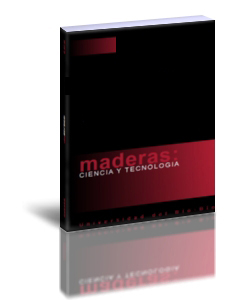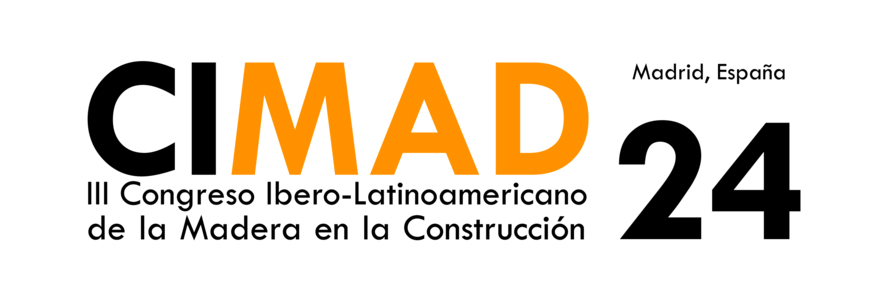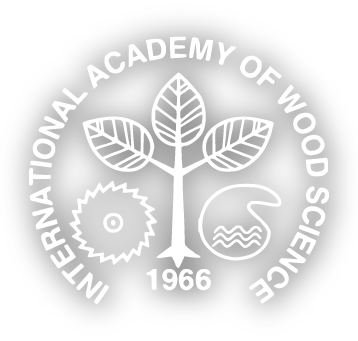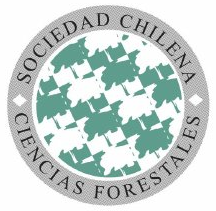Some physical and mechanical properties of particle boards produced from industrial wood chips and Scots pine (Pinus sylvestris) cones
DOI:
https://doi.org/10.22320/s0718221x/2025.14Keywords:
Larch chip, mechanical properties, particle board, physical properties, pinus sylvestris, raw material, scots pine cone, wood chipsAbstract
This study investigated the potential use of Scots pine cones as an alternative raw material to larch wood chips for particle board production. Due to the increasing scarcity of forest resources, exploring alternative raw material for the forest industry has gained importance in in recent years. Particle boards were produced in laboratory conditions by blending industrial wood chips with Scots pine cones in varying proportions (25 %, 50 %, 75 % and 100 %) and usingr urea formaldehyde glue. The adhesice mixture contained 55 % urea formaldehyde glue and 33 % ammonium chloride as a hardener. Te production parameters included a press temperature of 150 °C, a press time was 7 minutes, and a press pressure of 2,4 MPa to 2,6 MPa. The resulting boards had a thickness of 16 mm and a density ranging from 730 kg/m3 to 740 kg/m3. Tests for thickness iswelling, water absorption, , bending strength, modulus of elasticity and tensile strength perpendicular to the surface were conducted. Results showed that the physical and mechanical properties of the boards containing up to 25 % Scots pine cone met the required standards.
Downloads
References
Akyurek, S. 2019. The effect of luminescent (Pinus nigra J. F. var. şeneriana) wood on cell wall components and solubility values was investigated. Master’s Thesis. Kutahya Dumlupınar University, Institute of Science and Technology, Kütahya. https://acikbilim.yok.gov.tr/handle/20.500.12812/661177
Alma, H.A.; Kalaycıoglu, H.; Bektas, I.; Tutus, A. 2005. Properties of cotton carpel-based particleboards. Industrial Crops and Products 22(2): 141-149. https://doi.org/10.1016/j.indcrop.2004.08.001
Avcı, E. 2015. The use of wood plastic composites obtained using forestry waste in outdoor furniture. Selçuk Teknik Dergisi 14(2): 577-589. http://sutod.selcuk.edu.tr/sutod/article/view/258
Aras, U.; Kalaycıoglu, H.; Yel, H. 2014. Some of the Particleboards Produced from Pistachio Pine Cones Properties. In 3rd International Symposium on Non-Wood Forest Products: Kahramanmaras, country. 8-10 May 2014.
Aras, U.; Kalaycıoglu, H.; Yel, H.; Durmaz, S. 2016. Fire Performance, Decay Resistance and Surface Roughness of Particleboards made from Stone Pine (Pınus Pinea L.) Cones. Mugla Journal of Science and Technology 2(2): 96-99. https://dergipark.org.tr/en/download/article-file/387658
Arslan, M.B.; Karakus, B.; Guntekin, E. 2007. Fiberboard and particleboard productıon using agricultural waste. ZKÜ Bartın Orman Fakültesi Dergisi 9(12): 54-62. https://www.acarindex.com/pdfs/44455
Arslan, M.B. 2008. Surface chemical properties of forest and agrıculture residue based composites ınvestıgated. Master’s Thesıs. Department of Forestry Industrıal Engıneerıng, Isparta. https://acikbilim.yok.gov.tr/handle/20.500.12812/286852
Bal, B.C.; Ayata U. 2020. A comparative study on some mechanical properties of black pine and black poplar woods. Turkish Journal of Forestry 21(4): 461-467. https://dergipark.org.tr/tr/download/article-fi-le/1293428
Bektas, I.; Tutus, A.; Ugur, C. 2020. Investigation of the conformity of some mechanical properties of particleboards produced from cotton stalks to standards. Turkish Journal of Forestry 21(4): 445-450. https://doi.org/10.18182/tjf.741237
Bektas, I.; Guler, C.; Kalaycıoglu, H.; Mengeloglu, F.; Nacar, M. 2005. The manufacture of particleboards using sunflower stalks (Helianthus annuus L.) and poplar wood (Populus alba L.). Journal of Composite Materials 39(5): 467-473. https://doi.org/10.1177/0021998305047098
Buyuksari, U.; Ayrilmis, N.; Avci, E.; Koc, E. 2010. Evaluation of the physical, mechanical properties and formaldehyde emission of particleboard manufactured from waste stone pine (Pinus pinea L.) cones. Bio- resource Technology 101: 255-259. https://doi.org/10.1016/j.biortech.2009.08.038
Cavdar, A.D.; Yel, H.; Kalaycıoglu, H.; Aras, U. 2012. Physical and mechanical properties of cementitious particleboards produced with paper mill treatment water sludge. Journal of King Saud University - Engineering Sciences: 69-73. https://openaccess.artvin.edu.tr/xmlui/bitstream/han-dle/11494/1072/K%C3%A2%C4%9F%C4%B1t%20Fabrikas%C4%B1%20Ar%C4%B1tma%20Suyu%20%C3%87amuru%20ile%20%C3%9Cretilen%20%C3%87imentolu%20Yongalevhalar%C4%B1n%20Fizik-sel%20ve%20Mekanik%20%C3%96zellikleri.pdf?sequence=1&isAllowed=y
Cavuş, V.; Sahin, S.; Esteves, B.; Ayata, U. 2019. Determination of thermal conductivity properties in some wood species obtained from Turkey. BioResources 14(3): 6709-6715. https://doi.org/10.15376/bio-res.14.3.6709-6715
Chow, P.; Janoviak, J.J.; Price, E.W. 1986. The internal bond and shear strength of hardwood veneered particleboard composites. Wood and Fiber Science 18(1): 99-106. https://www.srs.fs.usda.gov/pubs/ja/ja_chow001.pdf
Eberhardt, T.L.; Young, R.A. 1996. Characterization of conifer seed cone Polysaccharides and lignin. Holzforschung 50: 401-407. https://www.degruyter.com/document/doi/10.1515/hfsg.1996.50.5.401/pdf
Ganenko, T.V.; Khamidullina, E.A.; Medvedeva, S.A. 2006. Chemistry of pinussylvestris cones. Chemistry of Natural Compounds 42: 612-612. https://link.springer.com/article/10.1007/s10600-006-0229-9
Guler, C.; Ozen, R. 2004. Some properties of particleboards made from cotton stalks (Gossypium hirsi- tum L.). Holz als Roh-und Werkstoff 62(1): 40-43. https://doi.org/10.1007/s00107-003-0439-9
Guler, C.; Bektas, I.; Kalaycıoglu, H. 2006. The experimental particleboard manufacture from sunflower stalks (Helianthus annuus L.) and calabrian pine (Pinus brutia T.). Forest Products Journal 56(4): 56-60.
Guler, C.; Copur, Y.; Buyuksari U. 2009. Producıng Particleboards From Hazelnut (Coryllus Avellana L.) Husk And European Black Pıne (Pınus Nıgra A.). Wood Research 54(1): 125-132. http://www.woodre-search.sk/wr/200901/12.pdf
Guler, C.; Buyuksari, U. 2011. Effect of production parameters on the physical and mechanical properties of particleboards made from peanut (Arachis hypogaea L.) hull. BioResources 6(4): 5027-5036. https://doi.org/10.15376/biores.6.4.5027-5036
Guler, C. 2015a. Utilization of Some Annual Plants in Wood-Based Composite Production. Selcuk University Journal of Engineering Sciences 14 (2): 70-78.
Guler, C. 2015b. Production of particleboards from licorice Glycyrrhiza glabra and European black pine (Pinus Nigra A.) wood particles. Scientific Research and Essays 10(7): 273-278. https://doi.org/10.5897/SRE2015.6193
Gunduz, G.; Masraf, Y. 2005. The effect of changing the production conditions on the mechanical and physical properties of the three-layer particleboard production. ZKÜ Bartın Orman Fakültesi Dergisi 7(8). 58-71. https://dergipark.org.tr/tr/download/article-file/472586
Guntekin, E. 2009. Some physical and mechanical properties of cement fiber boards subjected to rapid aging tests. SDÜ Isparta Orman Fakültesi Dergisi 2: 92-103. https://dergipark.org.tr/tr/download/article-fi-le/195741
Istek, A.; Kursun, C.; Aydemir, D.; Koksal, S.E.; Kelleci, O. 2017. The effect of surface layer chip ratio on particleboard properties. Journal of Bartin Faculty of Forestry 19(1): 182-186. https://dergipark.org.tr/tr/pub/barofd/issue/27137/307497
Istek, A.; Aydın, U.; Ozlusoylu, I. 2018. The Effect of Chip Size on the Particleboard Properties. In I CELIS’2018 International Congress on Engineering and Life Science: Kastamonu, Türkiye. 26-29 April, pp. 439-444.
Jianying, X.; Guenping, H.; Wong, E.D.; Kawai, S. 2003. Development of binderless particleboard from kenaf core using steam injection pressing. Journal of Wood Science 49(4): 327-332. https://doi.org/10.1007/s10086-002-0485-7
Kalkan, M.; Arık, G.; Cicekci, GS.; Yılmaz, M.; Parlak, S. 2021. The effect of western conifer seed bug (Leptoglossus occidentalis H.) on the soundness and germination of Anatolian black pine and scotch pine seeds. Research note. Tree and Forest 2(1): 29-34. https://dergipark.org.tr/tr/download/article-file/1773914
Kalaycıoglu, H. 1992. Evaluation of Vegetable Wastes in Particleboard Industry. In ORENKO’92 National Forest Products Industry Congress, Proceedings: Trabzon, Türkiye. 22-25 September 1992,pp.288-292. volumen I. https://avesis.ktu.edu.tr/yayin/661c5cb6-7dcf-4795-ad04-51dfbd7451a6/bitkisel-atiklarin-yonga-levha-endustrisinde-degerlendirilmesi-orenko-92-ulusal-orman-urunleri-endustrisi-kongresi
Kalaycıoglu, H.; Nemli, G. 2006. Producing composite particleboard from kenaf (Hibiscus cannabinus L.) stalks. Industrial Crops and Products 24(2): 177-180. https://doi.org/10.1016/j.indcrop.2006.03.011
Kardas, I. 2014. Examination of Kütahya-Simav region geothermal resources in terms of impregnation materials and investigation of the effects of these resources on some properties of wood. Master’s Thesis. Suleyman Demirel University, Institute of Science and Technology, Isparta. https://tez.yok.gov.tr/UlusalTezMer-kezi/tezDetay.jspid=CvH0T2DY2ZnqejPSAX_wxQ&no=5hvcqSlOEZfRHSunXnzKMw
Khedari, J.; Charoenvai, S.; Hirunlabh, J. 2003. New insulating particleboard from durian peel and coconut coir. Building and Environment 38(3): 435-441. https://doi.org/10.1016/S0360-1323(02)00030-6
Khedari, J.; Nonkangrob, N.; Hirunlabh, J.; Teekasap, S. 2004. New lost-cost insulating particleboards from mixture of durian peel and coconut coir. Building and Environment 39: 59-65. https://doi.org/10.1016/j.buildenv.2003.08.001
Mankowski, P.; Laskowska, A. 2021. Compressıve strength parallel to graın of earlywood and latewood of yellow pıne. Maderas. Ciencia y Tecnología (23): 1-12. https://doi.org/10.4067/s0718-221x2021000100457
Micales, J.A.; Han, J.S.; Davis, J.L.; Young, R.A. 1994. Chemical composition and fungitoxic activities of pine cone extractives. Editted by G.C. Llewellyn et al., Plenum Pres. Biodeterioration Research 4: 317-332. https://www.fpl.fs.usda.gov/documnts/pdf1994/mical94a.pdf
Moslemi, A.A. 1999. Emerging Technologies in Mineral-Bonded wood and fiber composites. Advanced Performance Materials 6(2): 161-179. https://doi.org/10.1023/A:1008777812842
Nemli, G.; Kirci, H.; Serdar, B.; Ay, N. 2003. Suitability of kiwi (Actinidia sinensis P.) prunings for particleboard manufacturing. Industrial Crops and Products 17(1): 39-46. https://doi.org/10.1016/S0926-6690(02)00057-2
Nemli, G.; Aydin, A. 2007. Evaluation of the physical and mechanical properties of particleboard made from the needle litter of pinus pinaster ait. Industrial Crops and Products 26(3): 252-258. https://doi.org/10.1016/j.indcrop.2007.03.016
Nemli, G.; Demirel, S.; Gumuskaya, E.; Aslan, M.; Acar, C. 2009. Feasibility of incorporating was- te grass clippings (Lolium perene l.) in particleboard composites. Waste Management 29(3): 1129-1131. https://doi.org/10.1016/j.wasman.2008.07.011
Oh, Y.S.; Yoo, J.Y. 2011. Properties of particleboard made from chili pepper stalks. Journal of Tropical Forest Science 23(4): 473-477. https://www.jstor.org/stable/23617062#metadata_info_tab_contents
Ors, Y.; Kalaycıoglu, H. 1991. Using of waste tea leaves on the particleboard industry. Turkish Journal of Agriculture and Forestry 15 (4) : 968-974. https://avesis.ktu.edu.tr/yayin/9e54730e-f49b-4eb6-b598-bc0028856548/cay-fabrikasi-atiklarinin-yonga-levha-endustrisinde-degerlendirilmesi
Ozsoylu, I.; Istek, A. 2015. Formaldehyde emission from panels used in furniture production and its effects on human health. SÜ Selçuk-Teknik Dergisi 14(2): 213-227. http://sutod.selcuk.edu.tr/sutod/article/view/228
Sanıvar, N.; Zorlu, I. 1980. Woodworking equipment knowledge: Basic course book. Vocational and Technical Education Books. National Education Printing House: Istanbul, Turkey. Survey and Programming Department Publications No 43. https://www.nadirkitap.com/agacisleri-gerec-bilgisi-orta-dereceli-endustriy-el-teknik-ogretim-okullari-temel-ders-kitabi-nazim-sanivar-irfan-zorlu-kitap26545271.html
Tascioglu, C.; Akcay, C.; Guler, C. 2018. Resistance of composites produced from some agricultural wastes against brown rot fungus fomitosis palustris. Düzce Üniversitesi Bilim ve Teknoloji Dergisi (6): 40-46. https://dergipark.org.tr/tr/pub/dubited/issue/34777/322390
TSE. 1999. Particleboards-specifications-part 2: Requirements for general-purpose boards for use in dry conditions. TS EN 312-2. 1999. TSE: Ankara, Türkiye.
TSE. 1999. Wood based panels, determination of modulus of elasticity in bending and bending strength. TS EN 310. 1999. TSE: Ankara, Türkiye
TSE. 1999. Particleboards and fiberboards, determination of swelling in thickness after immersion. TS EN 317. 1999. TSE: Ankara, Türkiye.
TSE. 1999. Particleboards and fiberboards, determination of tensile strength perpendicular to plane of the board. TS EN 319. 1999. TSE: Ankara, Türkiye.
TSE. 1999. Determination of moisture content of wood-based panels. TS EN 322. 1999. TSE: Ankara, Türkiye.
TSE. 1999. Wood based boards Unit volume weight determination. TS EN 323. 1999. TSE: Ankara, Türkiye.
TSE. 1999. Wood- Based panels- Sampling, cutting and inspection- Part 1: Sampling test pieces and exp- ression of test results. TS EN 326-1. 1999. TSE: Ankara, Türkiye.
TSE. 1997. Conditioning and/or standard atmospheres for trial and Standard reference atmosphere. TS 642-ISO 554. 1997. TSE: Ankara, Türkiye.
Var, A.A.; Kardas, I. 2017. Modulus of Rupture, Compression Strength Parallel to Grain And Static Quality Value Of Pine Wood Treated With Geothermal Waters From Simav Region Of Turkey. Bartın Orman Fakültesi Dergisi 19(1): 93- 101. https://doi.org/10.24011/barofd.295682
Yang, H.S.; Kim, D.J.; Kim, H.J. 2003. Rice straw-wood at the lot composite for sound absorbing wooden the construction materials. Bioresource Technology 86(2): 117-121. https://doi.org/10.1016/s0960-8524(02)00163-3
Downloads
Published
How to Cite
Issue
Section
License

This work is licensed under a Creative Commons Attribution 4.0 International License.
Los autores/as conservarán sus derechos de autor y garantizarán a la revista el derecho de primera publicación de su obra, el cuál estará simultáneamente sujeto a la Licencia de Reconocimiento de Creative Commons CC-BY que permite a terceros compartir la obra siempre que se indique su autor y su primera publicación esta revista.




































